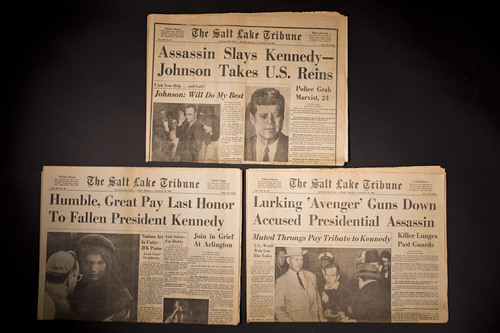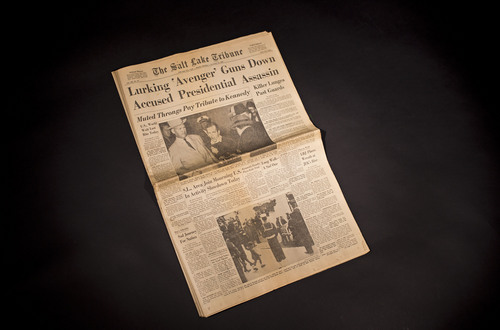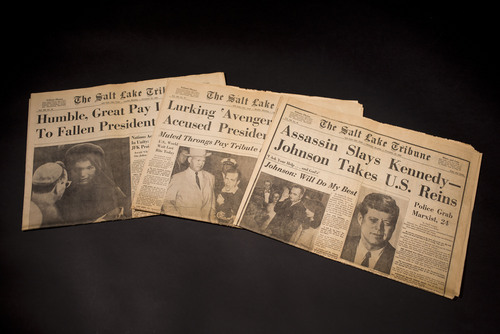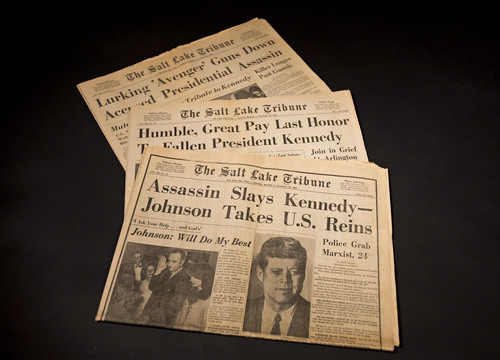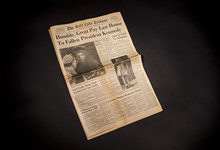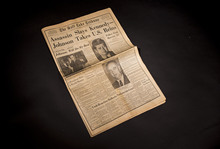This is an archived article that was published on sltrib.com in 2013, and information in the article may be outdated. It is provided only for personal research purposes and may not be reprinted.
If you're following the news at all this week, you've certainly seen plenty of reports — and will see many more in the next few days — commemorating the 50th anniversary of President John F. Kennedy's assassination on Nov. 22, 1963.
The Salt Lake Tribune published its own extensive package at sltrib.com and in the Nov. 17 print edition. We'll publish more stories Friday and Saturday as the pivotal event in U.S. history is remembered in ceremonies across the nation.
On display in our conference room here at The Tribune is a framed copy of the Nov. 23, 1963, newspaper in which the assassination was reported under the massive headline "Assassin Slays Kennedy — Johnson Takes U.S. Reins."
We've spent time looking back at those stories in the past few weeks, and found it interesting that The Tribune's coverage of Kennedy's assassination became the topic of a research paper by American University journalism student Win Brooks.
Brooks, of Mount Airy, Md., said he examined microfilm of The Tribune at the Library of Congress for his paper, which he shared with us.
"I believe such a piece would be interesting to your readers, given the upcoming 50th anniversary of the assassination," Brooks wrote in an email.
We agree. It is interesting.
Thanks for sharing it, Win.
The Tribune's Coverage of the Kennedy Assassination — A Retrospective
By Win Brooks
The assassination 50 years ago this week of President John F. Kennedy plunged the nation into grief and mourning. In its coverage, the The Salt Lake recognized the decisive and momentous importance of the president's death. It had to have been clear to readers of The Tribune November 23, 1963 that they were reading history as it was unfolding.
The front page of The Tribune on November 23, 1963 the assassination of President Kennedy in huge headlines, three inches high. "Assassin slays Kennedy- Johnson Takes Reins." The article opened with a lead that read: "Life couldn't be the same again. A good man, a great man, in the eyes of millions, was gone. He meant something to everyone, whatever they thought of him. And he was gone. And things couldn't be quite like they were."
In its first article about Kennedy's death, The Tribune captured the profound shock the assassination caused. The article speculated about long-term effects of the assassination, saying: "There will be another president, of course but it won't be Mr. Kennedy, nor his ideas and manners, nor their reflection in the world's destiny." article suggested the assassination's wide reaching effects, a moment in American history that would be remembered as marking a dramatic shift.
The article noted other, more mundane effects, too, including that "courts were adjourned, amusement places shut down, games were canceled, dinners called off."
A sidebar story on the front page that day described how Utah citizens responded to the news. "Utah Reaction Reflection Reflects Nationwide Guilt," the headline read. The article quoted the governor, George D. Clyde, as saying: "Our hearts are filled with sorrow…" David O. McKay, president of the Church of Jesus Christ of Latter-day Saints, was quoted as saying: "It is terrible to think that such a tragedy to occur, our prayers go in sincere and earnest appeal to the almighty that he will comfort the nation in this hour of tragic grief."
As if to emphasize the historic nature of the Kennedy assassination, The Tribune in "Tribune Tally," a small article at the bottom of the front page on November 23, 1963 "This is a tragically historic edition of The Salt Lake Tribune: a stark black and white report of history as it happens, of America in one of her darkest hours." The article told readers: "Here are the pictures and reports of an event which has shaken the world — and might alter its course. As Americans, as citizens — as mere humans caught up in this moment in history — you will want to read it all."
Most of Salt Lake City shut down that day. The Tribune reported that the bells of the Cathedral "tolled for 15 minutes," schools were dismissed at 2 p.m., an hour and a half early, and that "Salt Lake City and County offices, except those required by law to remain open, also closed." Salt Lake's police department and the county sheriff's office went on standby alert. The police chief, Ralph C. Knudson, was quoted as saying: "We don't expect anything, In fact, we don't know what to expect."
The Tribune also reported that, "Business went on as usual in downtown Salt Lake City stores, but stillness had crept over everyone."
The front pages of The Tribunein 1963 looked very different from those of today. On average, twice as many stories appeared on the front page 50 years ago than today. Photographs were far less common then, too. But in the days following the assassination, the Tribune seemed to make an exception. The number of front-page stories dropped significantly, from 12 on November 21st to just six on November 23rd. The number of photographs of Kennedy and President Lyndon B. Johnson also increased dramatically, from just one major picture November 21st to three on November 23rd.
The 's — and the timing of the news cycle — may have inadvertently encouraged people to turn to their television sets for news about the assassination. The first issue of the newspaper to report Kennedy's death came out on Nov. 23, 1963, the day afterward — and many hours after the television networks broke into their programming to begin wall-to-wall coverage that lasted four days. Perhaps as a result, The Tribune focused its coverage on the effects of the assassination, both locally and worldwide, and on the beginnings of Johnson's presidency.
Salt Lake City and the Tribune were quite different 50 years ago; but in reviewing the newspaper's coverage of the death of the president, the shock reverberates still.
Sources:
"Nation Shocked, Stunned," The Salt Lake Tribune (23 November 1963): A1.
Utah Reaction Reflection Reflects Nationwide Guilt," The Salt Lake Tribune (23 November 1963): A1.


